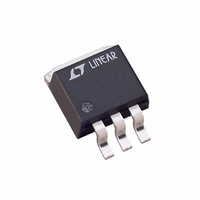LT1086CM-3.3#TR Linear Technology, LT1086CM-3.3#TR Datasheet - Page 8

LT1086CM-3.3#TR
Manufacturer Part Number
LT1086CM-3.3#TR
Description
IC REG LDO 1.5A POS 3.3V 3DD
Manufacturer
Linear Technology
Datasheet
1.LT1086CTPBF.pdf
(16 pages)
Specifications of LT1086CM-3.3#TR
Regulator Topology
Positive Fixed
Voltage - Output
3.3V
Voltage - Input
Up to 20V
Voltage - Dropout (typical)
1.3V @ 1.5A
Number Of Regulators
1
Current - Limit (min)
1.5A
Operating Temperature
0°C ~ 150°C
Mounting Type
Surface Mount
Package / Case
TO-263-2, D⊃2Pak (2 leads + Tab), TO-263AB
Lead Free Status / RoHS Status
Contains lead / RoHS non-compliant
Current - Output
-
Available stocks
Company
Part Number
Manufacturer
Quantity
Price
APPLICATIONS
LT1086 Series
The LT1086 family of 3-terminal regulators is easy to use
and has all the protection features that are expected in high
performance voltage regulators. They are short-circuit
protected and have safe area protection as well as thermal
shutdown to turn off the regulator should the temperature
exceed about 165 C at the sense point.
These regulators are pin compatible with older 3-terminal
adjustable devices, offer lower dropout voltage and more
precise reference tolerance. Further, the reference stabil-
ity with temperature is improved over older types of
regulators. The only circuit difference between using the
LT1086 family and older regulators is that they require an
output capacitor for stability.
Stability
The circuit design used in the LT1086 family requires the
use of an output capacitor as part of the device frequency
compensation. For all operating conditions, the addition of
150 F aluminum electrolytic or a 22 F solid tantalum on
the output will ensure stability. Normally capacitors much
smaller than this can be used with the LT1086. Many
different types of capacitors with widely varying charac-
teristics are available. These capacitors differ in capacitor
tolerance (sometimes ranging up to 100%), equivalent
series resistance, and capacitance temperature coeffi-
cient. The 150 F or 22 F values given will ensure stability.
When using the LT1086 the adjustment terminal can be
bypassed to improve ripple rejection. When the adjust-
ment terminal is bypassed the requirement for an output
capacitor increases. The values of 22 F tantalum or 150 F
aluminum cover all cases of bypassing the adjustment
terminal. For fixed voltage devices or adjustable devices
without an adjust pin bypass capacitor, smaller output
capacitors can be used with equally good results. The table
below shows approximately what size capacitors are needed
to ensure stability.
Recommended Capacitor Values
Normally, capacitor values on the order of 100 F are used
in the output of many regulators to ensure good transient
8
INPUT
10 F
10 F
22 F Tantalum, 150 F Aluminum
10 F Tantalum, 50 F Aluminum
U
OUTPUT
INFORMATION
U
W
ADJUSTMENT
U
None
20 F
response with heavy load current changes. Output capaci-
tance can be increased without limit and larger values of
output capacitor further improve stability and transient
response of the LT1086 regulators.
Another possible stability problem that can occur in mono-
lithic IC regulators is current limit oscillations. These can
occur because in current limit, the safe area protection
exhibits a negative impedance. The safe area protection
decreases the current limit as the input-to-output voltage
increases.That is the equivalent of having a negitive resis-
tance since increasing voltage causes current to decrease.
Negative resistance during current limit is not unique to
the LT1086 series and has been present on all power IC
regulators. The value of negative resistance is a function of
how fast the current limit is folded back as input-to-output
voltage increases. This negative resistance can react with
capacitors or inductors on the input to cause oscillation
during current limiting. Depending on the value of series
resistance, the overall circuitry may end up unstable. Since
this is a system problem, it is not necessarily easy to solve;
however, it does not cause any problems with the IC
regulator and can usually be ignored.
Protection Diodes
In normal operation the LT1086 family does not need any
protection diodes. Older adjustable regulators required
protection diodes between the adjustment pin and the
output and from the output to the input to prevent over-
stressing the die. The internal current paths on the LT1086
adjustment pin are limited by internal resistors. Therefore,
even with capacitors on the adjustment pin, no protection
diode is needed to ensure device safety under short-circuit
conditions.
Diodes between input and output are usually not needed.
The internal diode between the input and the output pins
of the LT1086 family can handle microsecond surge
currents of 10A to 20A. Even with large output capaci-
tances, it is very difficult to get those values of surge
currents in normal operation. Only with high value output
capacitors such as 1000 F to 5000 F, and with the input
pin instantaneously shorted to ground, can damage occur.
A crowbar circuit at the input of the LT1086 can generate
those kinds of currents and a diode from output to input is
then recommended. Normal power supply cycling or even
sn1086 1086ffs















